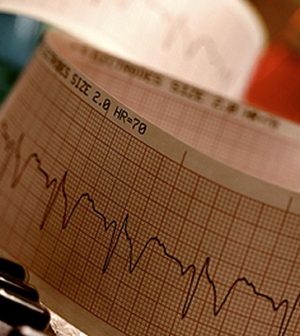- Navigating Your Midlife Crisis: Embracing New Possibilities
- City Raccoons Showing Signs of Domestication
- Mapping the Exposome: Science Broadens Focus to Environmental Disease Triggers
- One Week Less on Social Media Linked to Better Mental Health
- Your Brain Changes in Stages as You Age, Study Finds
- Some Suicide Victims Show No Typical Warning Signs, Study Finds
- ByHeart Formula Faces Lawsuits After Babies Sickened With Botulism
- Switch to Vegan Diet Could Cut Your Greenhouse Gas Emissions in Half
- Regular Bedtime Does Wonders for Blood Pressure
- Dining Alone Could Mean Worse Nutrition for Seniors
A-Fib More Common in Middle-Aged Folk Than Thought

The dangerous heart rhythm disorder called atrial fibrillation is becoming more common in middle-aged people, a new study warns.
More than a quarter of patients at the University of Pittsburgh Medical Center (UPMC) seeking care for A-Fib during the last decade were younger than 65, researchers found.
That’s much higher than the 2% prevalence of A-Fib commonly estimated among non-seniors, researchers said.
“Common knowledge among cardiologists is that, in people under 65, A-Fib is extremely uncommon and not detrimental. But there really hasn’t been any data to back that up,” said lead researcher Dr. Aditya Bhonsale, a UPMC cardiac electrophysiologist.
The study also found that younger patients with A-Fib were more likely to die or to be hospitalized for heart failure, stroke or heart attack.
Atrial fibrillation is a quivering or irregular heartbeat in the upper chambers of the heart. The condition increases a person’s risk of heart failure and stroke.
“At UPMC, we’ve been seeing a lot more young patients with A-Fib in recent years and have been interested in understanding the real-world clinical course of these individuals,” Bhonsale said in a university news release.
For the study, researchers drew on the electronic health records of more than 67,000 UPMC patients treated for A-Fib between 2010 and 2019.
During the decade, survival rates for male A-Fib patients were 30% to 50% worse than those without the condition.
The heart rhythm disorder was even harder on women, with survival rates 80% to more than three times worse for those with A-Fib than for those without.
These patients also had high rates of heart disease risk factors, including smoking, obesity, high blood pressure and sleep apnea.
“We are optimistic that data from this study will foster future investigation to evaluate optimal therapies for patients with A-Fib,” said senior researcher Dr. Sandeep Jain, director of cardiac electrophysiology at the UPMC Heart and Vascular Institute.
The new study was published April 22 in the journal Circulation: Arrhythmia and Electrophysiology.
More information
The American Heart Association has more about atrial fibrillation.
SOURCE: University of Pittsburgh, news release, April 22, 2024
Source: HealthDay
Copyright © 2025 HealthDay. All rights reserved.










